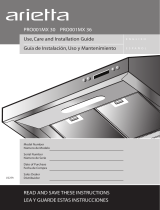
3
IMPORTANT SAFETY INSTRUCTIONS
Read All Instructions Before Using the Appliance.
READ AND SAVE THESE INSTRUCTIONS
WARNING
TO REDUCE THE RISK OF FIRE, ELECTRIC
SHOCK, OR INJURY TO PERSONS, OBSERVE
THE FOLLOWING:
A. Use this unit only in the manner intended by the
manufacturer. If you have questions, contact
the manufacturer.
B. Before servicing or cleaning the unit, switch
power o at service panel and lock service
panel disconnecting means to prevent power
from being switched on accidentally. When the
service disconnecting means cannot be locked,
securely fasten a prominent warning device,
such as a tag, to the service panel.
C. Installation Work and Electrical Wiring Must Be
Done By Qualied Person(s) In Accordance
With All Applicable Codes & Standards,
Including Fire-rated Construction.
D. Sucient air is needed for proper combustion
and exhausting of gases through the ue
(chimney) of fuel burning equipment to prevent
back- drafting. Follow the heating equipment
manufacturers guideline and safety standards
such as those published by the National Fire
Protection Association (NFPA), the American
Society for Heating, Refrigeration and Air
Conditioning Engineers (ASHRAE), and the
local code authorities.
E. When cutting or drilling into wall or ceiling, do
not damage electrical wiring and other hidden
utilities.
F. Ducted systems must always be vented to the
outdoors.
CAUTION
FOR GENERAL VENTILATING USE ONLY. DO
NOT USE TO EXHAUST HAZARDOUS OR
EXPLOSIVE MATERIALS OR VAPORS.
To reduce risk of re and to properly exhaust
air, be sure to duct air outside - do not vent
exhaust air into spaces within walls, ceilings,
attics, crawl spaces, or garages.
TO REDUCE THE RISK OF FIRE, USE ONLY
METAL DUCT WORK.
Install this hood in accordance with all
requirements specied.
WARNING
To Reduce The Risk Of Fire Or Electric Shock,
Do Not Use This Hood With Any External Solid
State Speed Control Device.
OPERATION
a. Always leave safety grills and lters in place.
Without these components, operating blowers
could catch onto hair, ngers and loose clothing.
The manufacturer declines all responsibility in the
event of failure to observe the instructions given
here for installation, maintenance and suitable use
of the product. The manufacturer further declines
all responsibility for injury due to negligence and
the warranty of the unit automatically expires due to
improper maintenance.
This unit is manufactured for indoor use only. Do not use this unit outdoors.
CAUTION
WARNING













